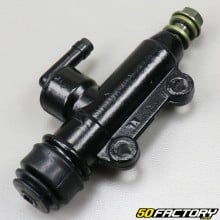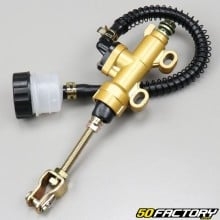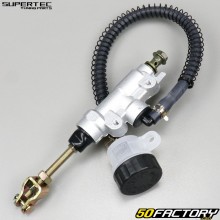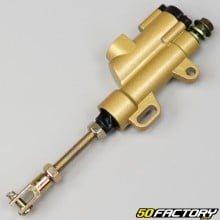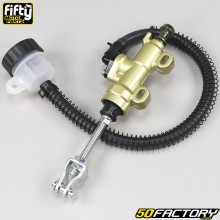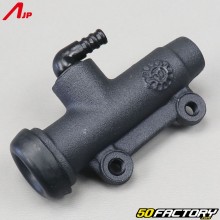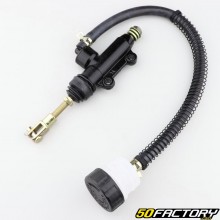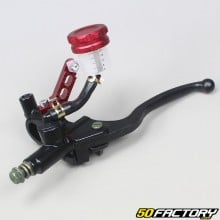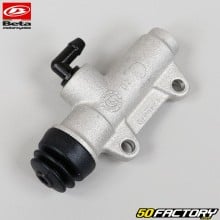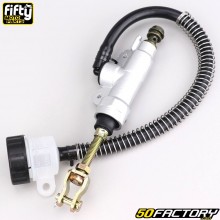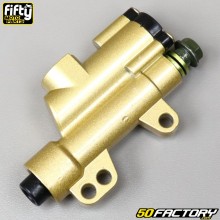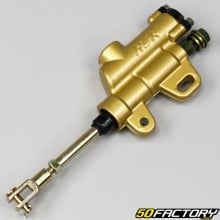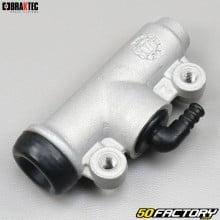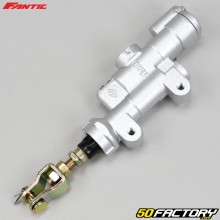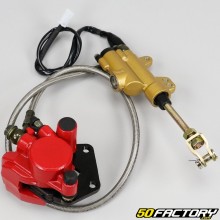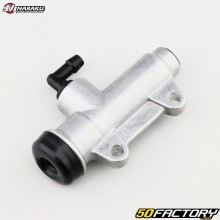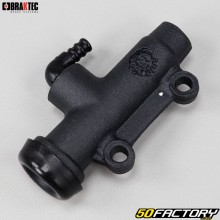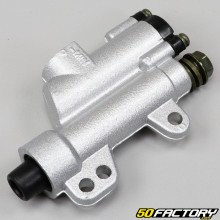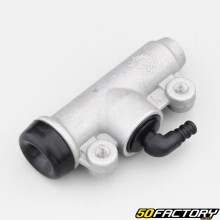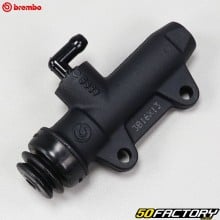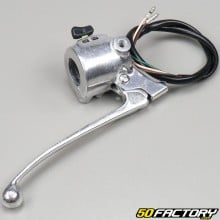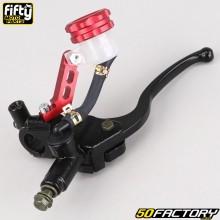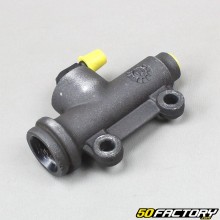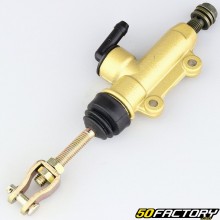 Rear brake master cylinder
Rear brake master cylinder
 Rear brake master cylinder
Rear brake master cylinder
-
-
-
- STOCK EXHAUSTED49€80
-
- STOCK EXHAUSTED16€50
- IN STOCK74€70
-
-
- STOCK EXHAUSTED89€40
-
- STOCK EXHAUSTED30€90
-
- STOCK EXHAUSTED49€80
-
- IN STOCK76€50
- IN STOCK155€30
- IN STOCK94€80
- IN STOCK55€90
-
-
-
-
- STOCK EXHAUSTED112€90
- STOCK EXHAUSTED-47% 27,00 € 14€31
- IN STOCK18€70
-
-
Understanding Your 50cc Motorcycle's Rear Brake Master Cylinder
Definition and role of this crucial element
The rear brake master cylinder is an essential component of your vehicle's braking system. Its role is to transform the pressure exerted byar the driver on the brake lever into hydraulic pressure in the brake lines. This is then transmitted to the calipers which actuate the brake pads against the discs to slow or stop the motorcycle 50. Its proper functioning is therefore essential to ensure effective and safe braking. A malfunction of this part can have serious consequences, compromising the ability of your vehicle to brake properly.
Device Operation
The rear brake master cylinder works by a piston that moves within a cylinder when the brake lever (or brake pedal) is operated. This movement of the piston compresses and force the brake fluid to pass through the brake hoses under pressure, thus activating the braking system. The piston spring helps return the brake lever to its original position when pressure is released, thereby releasing pressure in the brake lines.
The different types of master cylinders for the rear
There are several types of rear brake master cylinders, suitable for different types of vehicles and uses. Selecting the right model therefore depends on several factors, such as vehicle type, driving style or driving conditions.
Master cylinder suitable for motorcycles
For motorcycles, rear master cylinders are generally larger and more robust. They must be able to provide effective braking, even at high speeds. They can be equipped with dual piston systems for greater braking power.
Choosing the right master cylinder for your 50cc motorcycle
The choice of rear brake master cylinder depends on many factors. It is essential to select this part carefully to guarantee effective braking and a long life of the braking system.
Selection criteria
Before choosing a rear brake master cylinder, it is necessary to know the make, model and year of your vehicle. These elements will make it possible to determine the type of compatible master cylinder. Then, other criteria such as the diameter of the cylinder, the type of braking system (disc or drum) or the type of mounting (radial or axial) can guide the choice.
Tips for choosing the right model
It is recommended to refer to the vehicle owner's manual to choose the correct rear brake master cylinder. Particular attention must be paid to the quality of the part. Opting for a reliable brand generally guarantees a quality and durable product.
Installing a rear master cylinder
Replacing a rear brake master cylinder must be carried out with care. Incorrect installation can have consequences on safety and braking performance.
Installation steps
The installation begins par dismantling the old master cylinder, then installing the new one in the reverse order of dismantling. Brake line connections must be made carefully to avoid leaks and air bubbles. After installation, it is essential to bleed the braking system to eliminate any air present in the circuit. Follow our recommendations using the tutorial: Carry out a brake bleed.
Mistakes to avoid
The main mistakes to avoid when installing a rear brake master cylinder are not properly bleeding the system after installation and not checking for leaks after a few days of use.
Professional assistance
If you are not comfortable carrying out the installation yourself or if you have any doubts, do not hesitate to seek professional help. Braking is a crucial safety feature, so no risks should be taken when it comes to installation and maintenance.
Maintenance and detection of signs of wear
The rear brake master cylinder is subject to wear and requires maintenance to ensure its proper operation and lifespan.
Maintenance Tips
It is recommended to regularly check the level of brake fluid into the master cylinder reservoir and replace the fluid according to the manufacturer's recommendations. The master cylinder itself should be inspected regularly for signs of wear or deterioration. It is also necessary to perform regular maintenance on the system every 6 months, checking the level and quality of the brake fluid and inspecting all components for wear or failure.
Signs of wear to look out for
Signs of wear or a problem with a rear brake master cylinder may include a spongy feeling from the brake lever (or brake pedal), loss of stopping power, leaking brake fluid, or visible corrosion of the master cylinder.
Prevention of wear problems
Regular maintenance can prevent the majority of problems and extend the life of the master cylinder. Replacing the brake fluid at regular intervals helps prevent corrosion and wear of the master cylinder.
Selection of master cylinders at 50 Factory
We offer a wide selection of rear brake master cylinders suitable for all makes and models of two-wheelers. Our products are selected for their quality and reliability.
Presentation of the selection
Our selection includes master cylinders of different diameters, for disc or drum systems, and for both front and rear braking. They are available for all makes and models of 50cc motorcycles with gearbox.
Advantages of our rear master cylinders
Our rear brake master cylinders are chosen for their quality, durability and performance. They are designed par reliable and recognized brands in the field of two-wheelers.
Commitment to quality
We are committed to offering you quality products, attentive customer service and competitive prices. Our goal is your satisfaction and safety on the road.
Conclusion: The importance of the rear brake master cylinder for driving safety
The rear brake master cylinder plays a crucial role in the performance of the braking system of your two-wheeler and therefore in your safety on the road. Choosing it carefully, maintaining it regularly and replacing it when it is worn is therefore essential. Our experts are at your disposal to help you find the right master cylinder for your vehicle and to answer all your questions.
Remember to consult the other categories of the cycle part to find all your parts brake pads, brake lining and drum, brake disc, brake caliper, front brake master cylinder, rear brake master cylinder, rear brake pedal, brake hose and support, brake cable, caliper repair kit, master cylinder repair kit, caliper part, master cylinder part.
















































